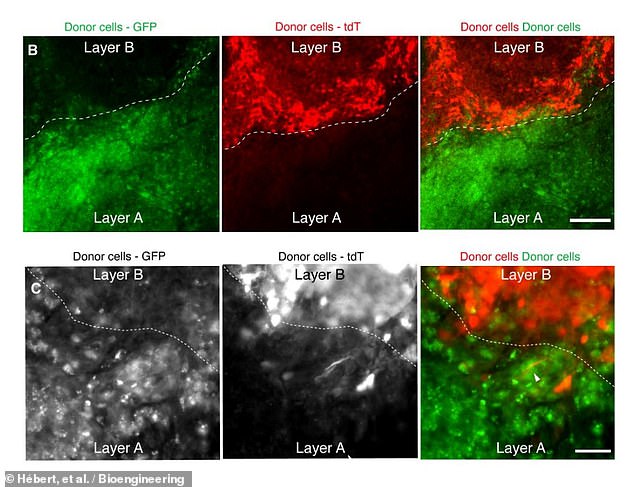NIH plan to circumvent death by repairing aging brains with youthful cells grown in labs
The US government is funding ‘completely insane’ brain transplant research aimed at ‘addicting’ death.
Geneticist Dr. Jean Hébert has received a $110 million grant from the NIH to develop an operation that can replace damaged or aging brain cells with tissue from human embryos.
This procedure involves repairing diseased brain tissue using laboratory-grown “neuronal” stem cells. The method has already shown promising results in mice.
A researcher has proposed a radical idea to cheat death that some scientists are calling ‘completely insane’
Stem cells are ’empty, shape-changing’ cells that can transform into cells from any other part of the body.
They are abundant in human embryos as a fertilized egg grows and specializes into a complex human being, and their use is central to this new, innovative approach.
“You don’t necessarily have to understand aging,” says Mark Hamalainen, co-founder of the Longevity Biotech Fellowship, said, “That’s why Jean’s work is interesting.”
But others in the field believe the procedure is too burdensome for general use, and the general public calls it ‘devils.’ (‘These are the creeps in charge of “science,”‘ as one online commenter wrote.)
Dr. Hébert’s initiative, more formally described as “functional brain tissue replacement,” showed its first signs of success in mice last year.
The results of that study prompted a government grant this month that will allow the studies to be conducted on primates first, before eventually moving on to human trials.
Laboratory mice with brain injuries underwent the procedure, in which scientists injected mouse stem cells into their aging brains, according to the study published in the journal Bio-engineering.
The stem cells were grown using cell culture, which involves isolating cells from an embryo and placing them in a petri dish with nutrients such as vitamins, amino acids, glucose and salts.
The team carefully placed a mixture of the lab-grown cells into a protein-based support gel from Corning called Matrigel Matrix, which derived from cell and tissue components that promote cell growth.
Dr. Hébert’s preliminary experiments in mice showed that these transplanted donor brain cells became “electrophysiologically active,” made contact with the brain of their host mouse, and even responded to “visual stimuli” within “one month of transplantation.”
“Using our paradigm, we found that neurons could differentiate and project to appropriate targets in the host brain,” Dr. Hébert and his team wrote in the study.
In other words, the young cells rapidly developed into specialized cells ready to fulfill their new role in the host brain.
“Moreover, the transplanted neurons were spontaneously active,” they added, “integrated (…) into functional networks” in the brain, without any additional work by the surgeons.
Electrode studies in mice in later tests also showed that these cells responded to sensory input.
Dr. Hébert’s successes attracted the attention of the National Institutes of Health (NIH) this year, leading to the new multimillion-dollar program.
The new US department is based on the Pentagon’s advanced research arm, DARPA. Agency for Advanced Health Projects (ARPA-H) was established in 2022 by President Joe Biden to play a similar forward-looking role within the NIH.
The new brain rejuvenation surgery joins ARPA-H’s efforts to transplant eyes to the blind, anticipate genetic evolution in cancer cells and develop radical new indoor air filters.
Dr. Hébert described the project as part of his life’s goal to become immortal.
“I was a weird kid and when I found out that we’re all falling apart and dying, I thought, ‘Why is everyone okay with this?’” the researcher explains.

The ARPA-H project will extend geneticist Dr. Jean Hébert’s tests of his surgical technique from previously successful transplants in mice to primates and other animals. Above, microscopic ‘immunofluorescence’ images show the successful layers of new brain cells in mice
“That’s pretty much what I do,” Dr. Hébert said. “I just prefer life to this slow degradation into nonexistence that biology has planned for all of us.”
The geneticist leaves the neuroscience department of the Albert Einstein College of Medicine in the Bronx for a job at a high-tech company, ARPA-H.
The ARPA-H project will expand Dr. Hébert’s testing of this surgical technique, which he previously performed successfully in mice, to other animals, including primates, the agency said.
But despite these promising successes, some scientists in the field have raised doubts about the surgery’s practicality and long-term feasibility.
“On the surface it sounds completely insane,” Matthew Scholz, CEO of the aging research company Oisín Biotechnologies, told MIT Technology Review“But I was surprised at how well he was able to argue it.”
However, Scholz does not expect the operation to become widespread or to usher in a new era of human immortality.
“A new brain is not going to be popular,” Scholz said. “The surgical aspect of it is going to be very invasive, no matter how you look at it.”
Others see the procedure as a possible remedy for hereditary cognitive problems.
“If it can work, forget about aging,” said Dr. Justin Rebo, a medical doctor and biotech entrepreneur. “It could be useful for all sorts of neurodegenerative diseases.”
